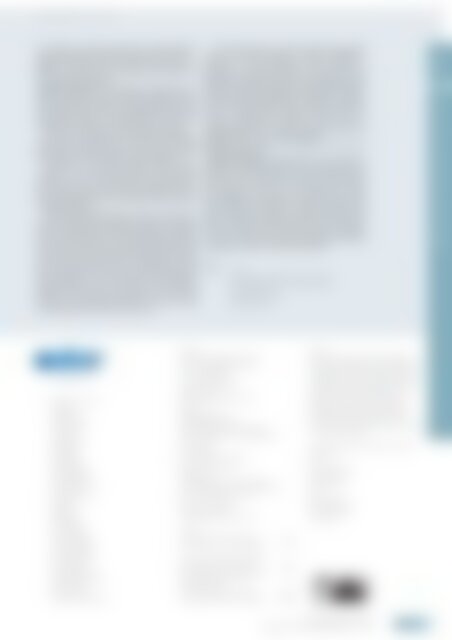Create successful ePaper yourself
Turn your PDF publications into a flip-book with our unique Google optimized e-Paper software.
<strong>atw</strong> Vol. 62 (<strong>2017</strong>) | Issue 6 ı June<br />
it is possible to complete this first unit by 2027-2029 and<br />
then we could go for a total of 6 GW by the early-2030s.<br />
NucNet: The Polish Nuclear Roadmap includes a plan to<br />
deploy a high-temperature gas-cooled reactor (HTR). Can<br />
you elaborate on these plans.<br />
Grzegorz Wrochna: The Polish nuclear programme is in<br />
nature a light-water reactor (LWR) investment project.<br />
The Polish industry will be part of the supply chain, but not<br />
much will be gained in terms of intellectual property and<br />
technological know-how. Fundamentally, we will order<br />
existing reactor designs, pay for them and build them.<br />
But once we have spent so much money on building a<br />
nuclear plant it might be better to spend a little bit extra<br />
and make even greater gains for the economy. We could<br />
invest in R&D, which would have lasting benefits for us.<br />
Poland has an extensive chemical industry, which<br />
consumes a lot of heat, produced from coal or imported<br />
natural gas. If we want to become more independent, we<br />
need an alternative source of heat for industry. And it is<br />
here that high temperature reactor HTR nuclear technology<br />
could play a big part.<br />
HTRs produce high-temperature steam at about 550 °C.<br />
We could safely and easily replace an old gas or coal-fired<br />
boiler at a chemical plant with an HTR which would produce<br />
the same amount of heat. We are talking about 6 GW, but<br />
this time in heat rather than in electricity, distributed among<br />
10 or more sites. This is a parallel programme, but there are<br />
obvious synergies between the two – supply chain, regulation,<br />
and the scientific part. We would really like to see the<br />
HTR programme as a spin-off from the main LWR programme.<br />
What we plan is to build about 10 to 20 HTRs in<br />
Poland by 2050. We have the capacity for this. The first<br />
should be in operation by 2031-2032. The need of Europe<br />
we estimate about 100-200 of such reactors.<br />
The HTR programme is also mentioned in government<br />
policy. Last year the ministry of energy established a<br />
committee for HTR deployment. That committee is<br />
preparing an intermediate report and this year we are<br />
planning to establish a company to start designing an HTR,<br />
based on international experience. Preparation for the first<br />
demonstrator will be supported by the Gemini+ initiative,<br />
which is being funded by Euratom. Within the framework<br />
of the € 4 million project, NCBJ scientists will be coordinating<br />
international preliminary works aimed at<br />
implementing HTRs. This could eventually help the first<br />
European HTR become a reality in Poland.<br />
NucNet: Finally, what are the challenges and risks for the<br />
new-build programme?<br />
Grzegorz Wrochna: The biggest risks do not come from<br />
cancellation or public opinion. They come from delays. In<br />
Europe, all major investments, power stations and other<br />
infrastructure, experience cost overruns and take longer<br />
than expected. In the past, the designs were several<br />
thousand pages long and the investment agreements a few<br />
pages. Today it is the opposite – designs are general and<br />
often standardised, while investment agreements have<br />
become long and cumbersome. Nuclear is no exception.<br />
This is a malaise that has affected all major investments<br />
in Europe. I hope the time spent preparing the nuclear<br />
programme in Poland will help avoid delays.<br />
Author<br />
NucNet<br />
The Independent Global Nuclear News Agency<br />
Editor responsible for this story: Kamen Kraev<br />
Avenue des Arts 56<br />
1000 Brussels, Belgium<br />
www.nucnet.org<br />
INSIDE NUCLEAR WITH NUCNET 375<br />
| | Editorial Advisory Board<br />
Frank Apel<br />
Erik Baumann<br />
Dr. Maarten Becker<br />
Dr. Erwin Fischer<br />
Dr. Peter Fritz<br />
Eckehard Göring<br />
Ulrich Gräber<br />
Iris Graffunder<br />
Dr. Ralf Güldner<br />
Carsten Haferkamp<br />
Dr. Norbert Haspel<br />
Dr. Petra-Britt Hoffmann<br />
Horst Kemmeter<br />
Prof. Dr. Marco K. Koch<br />
Ulf Kutscher<br />
Jörg Michels<br />
Roger Miesen<br />
Dr. Thomas Mull<br />
Dr. Ingo Neuhaus<br />
Dr. Joachim Ohnemus<br />
Prof. Dr. Winfried Petry<br />
Dr. Tatiana Salnikova<br />
Dr. Andreas Schaffrath<br />
Dr. Jens Schröder<br />
Dr. Wolfgang Steinwarz<br />
Prof. Dr. Bruno Thomauske<br />
Dr. Walter Tromm<br />
Dr. Hannes Wimmer<br />
Dipl.-Ing. Ernst Michael Züfle<br />
Imprint<br />
| | Editorial<br />
Christopher Weßelmann (Editor in Chief)<br />
Im Tal 121, 45529 Hattingen, Germany<br />
Phone: +49 2324 4397723<br />
Fax: +49 2324 4397724<br />
E-mail: editorial@nucmag.com<br />
| | Official Journal of<br />
Kerntechnische Gesellschaft e. V. (KTG)<br />
| | Publisher<br />
INFORUM Verlags- und<br />
Verwaltungsgesellschaft mbH<br />
Robert-Koch-Platz 4, 10115 Berlin, Germany<br />
Phone: +49 30 498555-0, Fax: +49 30 498555-19<br />
www.nucmag.com<br />
| | General Manager<br />
Christian Wößner, Berlin, Germany<br />
| | Advertising and Subscription<br />
Sibille Wingens<br />
Robert-Koch-Platz 4, 10115 Berlin, Germany<br />
Phone: +49 30 498555-10, Fax: +49 30 498555-19<br />
E-mail: sibille.wingens@nucmag.com<br />
| | Prize List for Advertisement<br />
Valid as of 1 January <strong>2017</strong><br />
Published monthly, 11 issues per year<br />
Germany:<br />
Per issue/copy (incl. VAT, excl. postage) 16.- €<br />
Annual subscription (incl. VAT and postage) 176.- €<br />
All EU member states without VAT number:<br />
Per issue/copy (incl. VAT, excl. postage) 16.- €<br />
Annual subscription (incl. VAT, excl. postage) 176.- €<br />
EU member states with VAT number<br />
and all other countries:<br />
Per issues/copy (no VAT, excl. postage) 14.95 €<br />
Annual subscription (no VAT, excl. postage) 164.49 €<br />
| | Copyright<br />
The journal and all papers and photos contained in it<br />
are protected by copyright. Any use made thereof outside<br />
the Copyright Act without the consent of the publisher,<br />
INFORUM Verlags- und Verwaltungsgesellschaft mbH,<br />
is prohibited. This applies to reproductions, translations,<br />
microfilming and the input and incorporation into<br />
electronic systems. The individual author is held<br />
responsible for the contents of the respective paper.<br />
Please address letters and manuscripts only to the<br />
Editorial Staff and not to individual persons of the<br />
association´s staff. We do not assume any responsibility<br />
for unrequested contributions.<br />
Signed articles do not necessarily represent the views<br />
of the editorial.<br />
| | Layout<br />
zi.zero Kommunikation<br />
Berlin, Germany<br />
Antje Zimmermann<br />
| | Printing<br />
inpuncto:asmuth<br />
druck + medien gmbh<br />
Baunscheidtstraße 11<br />
53113 Bonn<br />
ISSN 1431-5254<br />
Inside Nuclear with NucNet<br />
Q&A: Poland’s Progress on the Road to New Nuclear ı NucNet

















